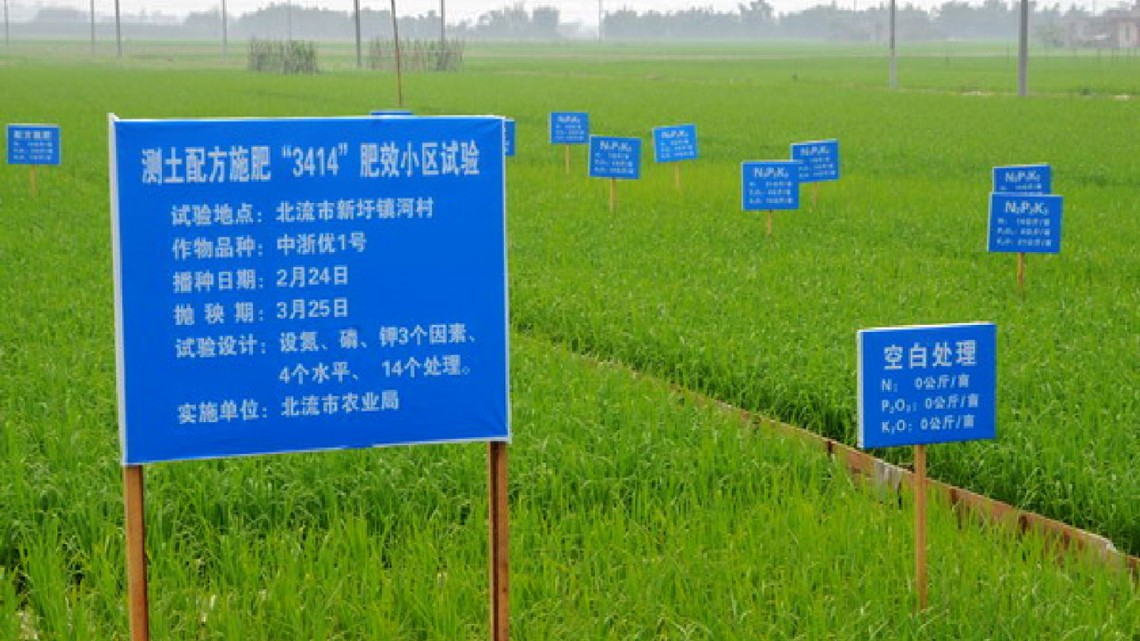
A field site in China from the National Soil Test and Fertilizer Recommendation Projects, which were conducted from 2005-13.
Better tech needed to increase soil organic carbon and crop yields
By Krishna Ramanujan, Cornell Chronicle
Increasing organic carbon in soils has been promoted as a way to help combat climate change while also improving soil fertility and crop yields, but a new paper shows that promised yield increases at a global scale would be negligible with current technologies and optimal management practices.
Importantly, the paper finds that regions with low food security, such as sub-Saharan Africa, might benefit more from any yield increases, if new ways can be developed to increase soil organic carbon to levels beyond what current agricultural management practices can achieve. Therefore, new strategies not yet in wide-spread use, such as redistributing carbon in the form of biochar, would need to be evaluated.
The paper, “Global Crop Production Increase by Soil Organic Carbon,” published Oct. 30 in Nature Geoscience, finds that available techniques to increase soil organic carbon would boost global crop production by only 0.7%.
“This is really the first credible quantitative study on ascertaining the effects of soil organic carbon on global crop yield and it is clear that crop yield does increase with increased soil organic carbon,” said Johannes Lehmann, the Liberty Hyde Bailey Professor in the School of Integrative Plant Science in the College of Agriculture and Life Sciences (CALS). “However, with current technology and optimal management, it’s not that much.”
Improved yields have been championed as an incentive for farmers to adopt strategies to sequester organic carbon in soils, which store 4-6 times the carbon found as CO2 in the atmosphere.
“Our study shows that the widespread belief that storing organic carbon in soils would generate large co-benefits to crop productivity is misguided,” said co-lead author Dominic Woolf, a senior research associate in the School of Integrative Plant Science Soil and Crop Sciences Section (CALS).
“If we want to store organic carbon in soils for its climate benefits, we will need to find ways to incentivize farmers to adopt and maintain good carbon management without assuming it will simply pay for itself with better harvests,” Woolf said.
At the same time, if future technologies can increase soil organic carbon to optimum levels, global production of the three most important staple crops (maize, wheat and rice) could rise by 4.3%, enough to feed an additional 640 million people.
The researchers found that soil organic carbon can improve yields for each crop only up to a certain point, beyond which there is no additional effect.
“The way to get to a 4.3% difference in global crop production is by doing things we don’t know how to do yet,” said Lehmann, a fellow at the Cornell Atkinson Center for Sustainability.
New technologies might include deep-rooted perennial crops, which are being widely researched, and biotechnologies such as maize varieties that pump more carbon into soil.
Redistributing carbon locally in the form of biochar – organic waste material or biomass that is partially combusted in the presence of limited oxygen to create a durable solid rich in carbon – could be a plausible solution, Lehmann said. Right now, methods to improve soil organic carbon rely on producing and retaining carbon onsite from plants grown in fields.
“We haven’t been thinking about transporting carbon from here to there,” Lehmann said. “With biochar, you can in principle make it in a city and transport it into an agricultural field a few hundred kilometers away.”
The study used data from field trials conducted in China from 2005-13 during the National Soil Test and Fertilizer Recommendation Projects. Wheat, rice and maize field trials from a total of 13,662 sites and 66,593 treatments were accessed. The sites crossed China and represented many climates and 90% of the soil types found on Earth. The trials were mostly conducted over single seasons, which allowed researchers to determine the effects of soil organic carbon on yields without the confounding factor that each season, leaf, stem and root litter adds to the existing carbon in the soil, in turn affecting yields.
The researchers then employed machine learning to extrapolate, under optimum soil management, what the yield effects might be in soil types across the globe.
“We should focus on these regions where an increase in crop yields will have an effect on food security and nourishment of populations,” Lehmann said. One caveat is that the data were obtained under optimal management strategies, including pesticides and fertilizers. The extent that food deficits could be lessened by soil organic carbon in food insecure countries that lack access to fertilizers and pesticides therefore remains unknown.
Woolf is co-lead author of the paper, along with Yuqing Ma, a PhD student at China Agricultural University and a former visiting scholar at CALS. Minsheng Fan, Ma’s advisor and a researcher at China Agricultural University, is a co-corresponding author along with Lehmann. Co-authors included researchers at the Ministry of Agriculture and Rural Affairs of the People’s Republic of China.
The study was funded by the National Key Research and Development Program of China, the National Natural Science Foundation of China, the Cornell Institute for Digital Agriculture and the USDANational Institute of Food and Agriculture.
Media Contact
Get Cornell news delivered right to your inbox.
Subscribe
